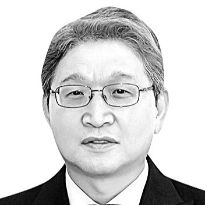Securing supply chains for rare earths and metals

Kang Chun-goo
The author is a visiting professor of energy resource engineering at Inha University.
During their Camp David summit, the leaders of Korea, Japan and the United States agreed to establish a trilateral early warning system (EWS) to stabilize the supply chains of essential materials for key products, including semiconductors. The intention was to strengthen economic security in response to China’s supply chain threats. The EWS is a framework for the three countries to share information early and prepare countermeasures to minimize the impact on supply chains when materials for chips and batteries are in short supply. According to the agreement, the Korean government will come up with a plan for cooperation through regular trilateral consultations and play a leading role in multilateral consultative bodies such as the Crucial Minerals Security Partnership and the Partnership for Resilient and Inclusive Supply-chain Enhancement.
After the United States recently decided to restrict exports of cutting-edge semiconductor equipment to China, Beijing responded by restricting exports of gallium and germanium, rare metals used in semiconductors. Prices of related minerals are fluctuating as China rolls out retaliatory measures one after another, targeting items where the country has dominated global supplies. According to the Korea Mine Rehabilitation and Mineral Resources Corporation, the average price of gallium for two weeks in August was $345 per kilogram, a 22.1-percent increase in just one month. The germanium price also rose 7.4 percent to $1,440 per kilogram from $1,340 per kilogram a month ago.
As a supremacy competition between the world’s two largest economies intensifies, concerns about the spread of resource nationalism and its aftermath are growing. The global market, which has supported the world economy since the Cold War, is fast collapsing and many industries will feel the impact.
According to the European Commission, major minerals, where China controls more than 60 percent of the global market, include dysprosium (100 percent), terbium (100 percent), gallium (94 percent), magnesium (91 percent), neodymium (85 percent), germanium (83 percent) and natural graphite (67 percent). Moreover, China invested $10 billion in overseas resource development projects in the first half of 2023, a 131-percent increase on year. The investments were made in resource-rich countries in Africa such as Namibia and Tanzania, Bolivia in South America and Indonesia in Southeast Asia.
China is strategically blocking the supplies of key minerals, putting the production of high-tech products in major countries at risk. In particular, gallium and germanium, where Beijing recently announced controls on exports, are used in high-tech industries such as chips and organic light emitting diodes (OLEDs), as well as war materials such as night vision goggles.
According to the U.S. Geological Survey, eight out of 13 major strategic military minerals, including tungsten, vanadium, rare earths and gallium, are difficult to produce without Chinese support. Rare earths in particular are a serious problem. The United States is strengthening its ties with Canada and Australia to establish a rare earths supply chain by 2025 but the immediate supply is an issue. Washington is also reliant on China for the supply of various key minerals, even indirectly, until 2030 at least.
Seoul said Beijing’s measures will not have a significant impact, but the problem will arise when China expands its battle against major countries by controlling the global minerals market. As a result, the European Union (EU), following the United States, is expanding its supply chains through Critical Raw Materials Act.
In an attempt to create supply chain networks centered on their own benefits, major countries are establishing supply chain cooperation channels while strengthening regulations to protect their key companies and technologies. The United States formed the Indo-Pacific Economic Framework (IPEF) in October 2021. The EU established a strategic partnership for raw materials in September 2020, and Japan launched a supply chain initiative linking Japan, India and Australia in April 2021.
It was a good decision for Korea to participate in the early warning system for a trilateral supply chain, and Seoul should establish a Korean-style global supply chains partnership. By utilizing cooperation basis — such as beneficiaries of the official development assistance projects and members of the free trade agreement networks — the government must start operating supply chain cooperation channels with the countries that are willing to cooperate.
The government needs to categorize those countries by dividing them into one group, where cooperation can be led by businesses based on their raw material production infrastructure, and another group that needs cooperation in the public sector. For corporate-led initiatives, the prospects are bright for mining in Australia and Vietnam while Indonesia and the Philippines are known for nickel production and Chile is promising for lithium and copper production. The government initiatives will be suitable for Kazakhstan, Uzbekistan and Kyrgyzstan, which have affluent crucial minerals and where many ethnic Koreans live.
Translation by the Korea JoongAng Daily staff.










with the Korea JoongAng Daily
To write comments, please log in to one of the accounts.
Standards Board Policy (0/250자)